Normal view
Jaguar plans to close the loop on recycling seat foam
2025 Ford F-150 Lightning carries on for $65,090
-
Wisconsin Examiner
- Activists occupy Wisconsin DNR offices to protest Line 5 pipeline permit approval
Activists occupy Wisconsin DNR offices to protest Line 5 pipeline permit approval
Activists marched from the Capitol to the DNR Monday to demand the agency rescind its permit for Enbridge Line 5. | Photo courtesy Ian Phillips
A group of about 50 activists occupied the lobby of the Wisconsin Department of Natural Resources Monday to protest the agency’s approval of a permit to construct a 41-mile reroute of Enbridge’s Line 5 oil pipeline through northern Wisconsin.
Several members of the group tried to enter further into the building and one activist was arrested and put in jail, according to a news release from the coalition of indigenous and environmental groups who planned the protest. Two others were warned they’d be arrested if they tried to enter the building again.
For years, the Bad River band of Lake Superior Chippewa have fought against the pipeline, 12 miles of which crosses the tribe’s reservation, raising concerns about the pipeline’s effect on local water and the broader effects that fossil fuels have on the environment.
After declining to renew the easement that allowed the pipeline to cut across their land, the tribe sued in federal court to have it removed. In 2022 a judge ruled that Enbridge was trespassing and would have to reroute the pipeline.
The tribe is opposed to the proposed route for the new pipeline because it would be directly upstream of the reservation.
Late last year, the DNR granted a crucial permit approval for the relocation just days after another of Enbridge’s pipelines, Line 6, was found to have leaked more than 69,000 gallons of oil in the Jefferson County town of Oakland.
On Monday, the group of activists marched from the state Capitol to the DNR offices to deliver a letter demanding that the agency revoke its permit approval and support the decommissioning and removal of Line 5.
“Enbridge Line 5 abets mayhem all around the world: deforestation and water pollution in Alberta, where companies scrape tar out of sand; oil spills across Wisconsin and Michigan; and the global heating equivalent of detonating hundreds of atomic bombs in the atmosphere every single day,” Greg Mikkelson, an organizer with the Cross Border Organizing Working Group, said in a statement. “The proposed expansion of this pipeline would lock in dependence on this disaster-genic source of energy for decades to come. Meanwhile, Wisconsinites consume virtually none of the oil or gas carried in Line 5. Shame on the DNR for approving the expansion, even while covering up a brand-new spill from Line 6, another Enbridge pipeline in Wisconsin.”
GET THE MORNING HEADLINES.
Wednesday marks deadline for health insurance sign-up under Affordable Care Act
A doctor takes a blood pressure reading for a pregnant woman. Wednesday is the deadline for signing up for individual health insurance under the Affordable Care Act. (Getty Images)
Wednesday is the final deadline this year for people who want to sign up for health insurance through the Affordable Care Act.
Wisconsin has already set a new record for enrollment, according to preliminary information from the federal Centers for Medicare & Medicaid Services (CMS), part of the Department of Health and Human Services.
The health care marketplace, https://healthcare.gov, was established as part of the Affordable Care Act for consumers who don’t have affordable health insurance through work or through government programs such as Medicaid. Individuals and families can purchase health insurance policies at Healthcare.gov.
The most recent federal data from CMS shows sign-ups through Jan. 4. On Friday, Gov. Tony Evers announced that in Wisconsin, 306,470 residents had signed up as of that date — an all-time high for the state.
Through 2025, plans purchased through the marketplace are also supported by enhanced federal subsidies, lowering their monthly insurance premium cost depending on a family’s income.
The future of the subsidies beyond this year is uncertain. Advocates are trying to pressure Republicans in Congress to maintain them as they negotiate other tax changes in the coming months.
Sens. Tammy Baldwin (D-Wis.) and Jeanne Shaheen (D-N.H.) have introduced legislation to extend the enhanced subsidies and make them permanent.
The ACA advocacy group Protect Our Care cheered the legislation when it was introduced last week. “If Republicans succeed in taking away these tax credits, health care costs will increase by an average of $2,400 for working families, and five million people will lose their health care altogether,” said Leslie Dach, the group’s chair.
For people seeking guidance in how to choose coverage, Covering Wisconsin, at https://coveringwi.org/, is a federally funded navigator to help people to assess their health insurance options, including through the federal health insurance marketplace.
The Wisconsin Office of the Commissioner of Insurance (OCI) and the Department of Health Services (DHS) also outline options through WisCovered, a joint website. OCI also has a website that consumers can visit to find which ACA-approved insurers are operating in their region of the state: https://oci.wi.gov/Pages/Consumers/FindHealthInsurer.aspx.
GET THE MORNING HEADLINES.
U.S. Senate hearing on Interior nominee postponed until Thursday
Former North Dakota Gov. Doug Burgum participates in a swearing-in ceremony of state lawmakers on Dec. 2, 2024, in Bismarck, North Dakota, shortly before completing his term as governor. (Photo by Michael Achterling/North Dakota Monitor)
WASHINGTON — Utah Sen. Mike Lee announced Monday he had postponed the confirmation hearing for two days for President-elect Donald Trump’s pick to lead the Interior Department.
Lee, chairman of the Energy and Natural Resources Committee, delayed former North Dakota Gov. Doug Burgum’s hearing, which had been scheduled for Tuesday, until Thursday.
“Governor Doug Burgum has been fully cooperative throughout the confirmation process, promptly submitting his paperwork to the Office of Government Ethics,” Lee wrote in a statement. “Despite his compliance and the Energy and Natural Resources Committee noticing the hearing in accordance with all rules, OGE has yet to complete its review. This bureaucratic delay is unacceptable.”
Lee wrote the extra 48 hours was meant to give the Office of Government Ethics a bit more time to wrap up its work, but cautioned the agency should work quickly.
“To ensure transparency and uphold the integrity of this process, the committee will postpone Governor Burgum’s hearing until Thursday,” Lee wrote. “However, we expect OGE to act with urgency and complete its review without further unnecessary delays. The American people deserve a government that operates efficiently to advance their priorities, and we remain committed to ensuring these critical confirmations move forward as quickly as possible.”
Senate Minority Leader Chuck Schumer, a New York Democrat, and Energy and Natural Resources Committee ranking member Martin Heinrich, D-N.M., both raised concerns last week about Burgum’s hearing taking place before certain paperwork was filed with the committee.
“The Senate has a constitutional duty to advise and, if it determines, consent to the President’s nominees. This requires careful consideration of each nominee,” Heinrich wrote in a statement released last week. “To achieve this, for decades, nominees that have come before the ENR Committee have submitted responses to a standard questionnaire and a completed financial disclosure form, approval from the Department’s ethics office, and completion of an FBI background check. Until these steps have been completed, I will not consent to notice of nomination hearings.
“Every nominee, every party, every administration should be subject to the same standards. I would urge Chairman Lee to reconsider his decision.”
Heinrich and seven other Democrats on the committee and one independent released a letter Monday morning, urging Lee to delay the hearing until the panel received “the standard financial disclosure report, ethics agreement, or the opinions from the designated agency ethics officer and the Office of Government Ethics stating that the nominee is in compliance with the ethics laws.”
“In view of the fact that the Committee still does not have these documents, which are essential for us to faithfully discharge our constitutional advice-and-consent responsibilities, we respectfully request that you postpone the scheduled hearing on Governor Burgum’s nomination for at least a week to give Members sufficient time to receive and review these materials,” the lawmakers wrote.
Those lawmakers included Maria Cantwell, D-Wash., Catherine Cortez Masto, D-Nev., Ruben Gallego, D-Ariz., John Hickenlooper, D-Colo., Mazie Hirono, D-Hawaii, Angus King, a Maine independent, Alex Padilla, D-Calif. and Ron Wyden, D-Ore.
The Senate Veterans’ Affairs Committee, led by Kansas Republican Sen. Jerry Moran, later on Monday postponed its Tuesday hearing for Trump’s pick to lead the VA, citing an uncompleted background check.
“Congressman Doug Collins has submitted all his paperwork in a timely manner and has been transparent and forthcoming with the committee,” Moran wrote in a statement. “At this time, the FBI has not completed its customary background check of Congressman Collins. In accordance with long-standing practice, the committee should have an opportunity to review Congressman Collins’ FBI file before the confirmation hearing. I expect the FBI to complete its review quickly so that the committee can move forward with its role of evaluating the President’s nominee.”
Trump announced in November that he had selected the former Georgia congressman to lead the VA.
-
Wisconsin Examiner
- Ten years after its creation, Office of Children’s Mental Health confronts worsening crisis
Ten years after its creation, Office of Children’s Mental Health confronts worsening crisis
Young girl staring out her window | Getty Images creative
Hannah Brecke, a youth leader and student at Port Washington High School, said she has dealt with mental health issues for “as long as I can remember,” but her troubles were exacerbated in middle school when her mother was placed in the hospital due to an illness. She said she started attending school less because of her anxiety about her mom, and when her mother passed two weeks later, she didn’t know how to handle it.
“I cried every night for my mom for two years. I wanted to die… I slept all day, didn’t talk to anybody and disappeared from society. I didn’t want to get better. I wanted to suffer like this because if I didn’t, I felt that it meant I didn’t miss and love my mom,” Brecke said.
It wasn’t until her sophomore year, Brecke said, that she realized she “wanted to live” for her mom. It was then she said that she started attending therapy and was prescribed medication to help her with her mental health.
“Even if the meds didn’t help, at least I could say, I was trying. About six months into taking my meds, I began to notice that I wanted to do things more. I wanted to talk to people more,” Brecke said. “My grief will never go away, but at least now it is manageable.”
Brecke and Kayla Winston, a student at Case High School, told their stories of dealing with mental struggles during the Office of Children’s Mental Health (OCMH) annual briefing Friday.
Brecke and Winston are just two Wisconsin youths, who have dealt with mental health struggles in recent years. This year’s annual briefing provided an opportunity to assess 10-year trends in youth mental health and to discuss solutions Wisconsin could try to address ongoing challenges. The Office of Children’s Mental Health was created by 2013 Wisconsin Act 20 and launched its work in early 2014 to help coordinate mental health initiatives across the state and track data about children’s mental health to inform its efforts.
OCMH Director Linda Hall said listening to young people’s stories and their answers about how to address what’s happening with youth mental health is essential for tackling ongoing concerns.
“Our young people are living through so much and it’s very different from the world that most of us grew up in,” Hall said during the briefing.
Amy Marsman, OCMH’s senior research analyst, highlighted a number of concerning trends to notice over the last 10 years. They included a 42% increase in the number of youth reporting symptoms of depression, a 29% increase in those reporting anxiety with two-thirds of female
high school students reported having problems, a 21% increase in those reporting self-harm and a 41% increase in those reporting that they’ve considered suicide.
“Sometimes, in an effort to diminish emotional pain, people purposely hurt themselves. It may be cutting, burning or bruising oneself without wanting to die, and these self-harm rates have increased statewide since 2014,” Marsman said.
Other areas of concern highlighted by the report include half of children age 3 to 17 with a mental health condition not receiving treatment; an increase in the number of young adults age 18 to 25 with mental health illnesses; the majority of doctors not asking parents with children age 0 to 5 about learning, development or behavioral problems; a decline in the number of teens with a trusted adult at school and a decline in the number of teens who feel like they belong in school.
Winston of Racine Case High School highlighted some of the ways she was able to find support when she began having mental health problems after starting high school a couple years into the COVID-19 pandemic. She said joining band helped give her a sense of belonging at the school. She said her peers helped support her through some of the struggles that she dealt with and that having a trusted adult in school was also important.
Winston said that she also eventually started therapy to help with her depression.
“I had to do a lot of learning about myself,” Winston said.
Hall highlighted some of the stressors affecting Wisconsin youth, including academic pressures, gun violence, political divisiveness, racism and discrimination and climate change.
The annual briefing highlighted some areas of improvement over the last five years, including that the number of psychiatrists in Wisconsin and the number of school-based mental health professionals have increased.
“Though the number of school-based mental health professionals has increased, totals are still below recommended levels and their services are not reimbursed at sustainable rates,” Marsman said. “Fixing school mental health reimbursement rates is key to addressing Wisconsin’s youth mental health crisis since the majority of Wisconsin kids who receive services get them at school.”
Potential policy solutions
At the briefing, Rep. Patrick Snyder (R-Weston), who chairs the Assembly Children and Families Committee and sits on the Mental Health and Substance Abuse Prevention Committee, along with Sen. LaTonya Johnson (D-Milwaukee) highlighted several potential policy proposals that could help address ongoing mental health issues among children.
One proposal, which Snyder said he spoke with a pediatric psychologist about, is implementing universal wellness screenings starting at the age of 5. He said a screening could serve as a “great opportunity” to allow young children to speak to someone, and that if they continue until the age of 18, the program could be connected to schools.
“As we’ve seen from the data, a lot of the data points we get come from kids that just go through puberty or in their teens, but what was going on before that? Snyder said.
Snyder added that he is interested in providing more mental health funding for schools as well as investments in adult care.
“If somehow we get the child back on the road to recovery, you don’t want to send them back into an environment that hurts the work you were able to accomplish,” Snyder said.
Snyder and Johnson both discussed creating psychiatric residential treatment facilities — or PRTFs — in Wisconsin. The Legislative Fiscal Bureau has described them as long-term facilities that typically offer treatment for children diagnosed with psychiatric conditions, including bipolar disorder, disruptive behavior disorders, substance use disorders, severe emotional disturbance or post-traumatic stress disorder.
The lawmakers participated in a study committee in 2024 that examined the current state of Wisconsin’s emergency detention and civil commitment laws as they applied to children and came up with some suggestions for improvement. The creation of these facilities was one major point of discussion, along with the issue of youth being sent out of state for treatment.
Wisconsin does have three youth crisis stabilization facilities, but those are short-term facilities with a maximum of eight beds. There are currently no residential psychiatric treatment facilities in the state.
“We need to do better of ensuring that we have these residential treatment centers right here in this state where [youth are] closer to home, they’re closer to their families and once they get out, they can continue that continuum of care without it being piecemealed and in some cases just missed all together,” Johnson said.
Johnson said she also wants to see more mobile crisis response teams across Wisconsin to take some of the burden of dealing with mental health crises off law enforcement.
“Mental health is a crisis, but it’s a crisis that’s too often met with law enforcement — individuals that don’t necessarily have the training to adequately address these issues due to no fault of their own.” Johnson said. “It puts a strain on our police department, but it also teaches our minors that having mental health [struggles] isn’t necessarily in some cases acceptable.”
Johnson said resources for these initiatives need to be statewide and not just concentrated in one part of the state.
“In some cases,…we may do a good job in Milwaukee but not necessarily a good job in the rural areas and our kids matter, no matter where they’re at,” Johnson said.
GET THE MORNING HEADLINES.
School software provider is the latest target of major hack of personal data
Education software company PowerSchool is the latest major American company to be targeted by hackers, who accessed the personal data of millions of parents and students. (Photo illustration by seksan Mongkhonkhamsao/Getty Images)
The sensitive data of millions of American adults and children have been compromised after hackers targeted California-based education software company PowerSchool, the company confirmed last week.
The breach happened at the end of December, and new information confirmed by TechCrunch Thursday morning says that hackers were able to access student addresses, Social Security numbers, grades and medical information on the platform, which schools use for student records, grades, attendance and enrollment.
The names, phone numbers and emails of parents and guardians were also potentially compromised, the company said. Hackers were able to use a stolen credential, or login, to access the internal customer support portal, the company said. PowerSchool currently has 16,000 customers, and is used by more than 50 million students across North America, the company confirmed.
The incident is the latest large-scale data breach in the U.S., as year after year, the number of cybercrimes continues to rise. The FBI’s Internet Crime Complaint Center recorded 880,418 complaints in 2023, a 10% increase from the complaints registered the year prior, and nearly double the number of crimes reported in 2019. The agency estimates potential monetary losses due to cybercrime since 2019 to be $37.4 billion.
PowerSchool’s breach is an example of how cyber criminals profit — the company said it was extorted into paying a sum to prevent hackers from leaking the stolen data, though it did not say how much.
The hackers’ method of using legitimate credentials to access the internal software is much more common than you might think, said Rob Scott, Dallas-based managing partner of technology law firm Scott & Scott LLP. When people think about hacking, they likely picture automated attacks that pass through logins and passwords, he said.
Many breaches come from accounts purchased on the so-called Dark Web, a vast expanse of the internet that is inaccessible to most conventional browsers, Scott said.
“Or employee negligence situations … poor password management, or IT policies around managing and keeping passwords safe and confidential,” he said.
This incident was not an example of a ransomware attack, where hackers use software or malware to encrypt data on a computer, and prevent users from accessing their device. There were 2,835 ransomware crimes in 2023, and healthcare, manufacturing and government facilities were most targeted.
But the motivation for the majority of cyber crimes is financial, Scott said.
“People used to pickpocket, right? People used to rob banks,” Scott said. “Cybersecurity is the modern equivalent of those types of activities.”
As these data breaches become more common, you’re likely right in assuming that your data has been compromised in some way by now, said Chandler, Arizona-based Kiran Chinnagangannagari, cofounder and chief product and technology officer at cybersecurity firm Securin.
The advancements of generative AI systems have made the internet a data hungry place, Chinnagangannagari said, because these systems need tons of information to learn and get better.
While about 20 states have consumer data privacy laws, and all 50 states have data breach notification laws, Chinnagangannagari and Scott said they don’t find legislation is a big help in fighting this growing problem. Many of the laws put responsibility on the company to inform consumers, Scott said, but it places extra burden on a company that was just the victim of a crime.
Chinnagangannagari said laws that encourage proactive safeguarding against unnecessary data collection are more helpful. HIPAA, for example, sets strict rules on how healthcare providers can collect, store and share health data. The California Consumer Privacy Act, as amended by the California Privacy Rights Act, includes purpose limitation and data minimization rules.
While there’s little an individual can do in the wake of these large-scale attacks on a corporation or organization, users can take some actions toward proper “cyber hygiene,” Chinnagangannagari said.
Be protective of where you are putting your information, and learn what you can about terms and conditions of large platforms or apps you sign up for. You should set up a system of not reusing passwords, and utilize multi-factor authentication when you can. There are also services that will seek out your data and warn you when it’s been part of a widespread breach, the cybersecurity pro said.
And while it can feel helpless, Chinnagangannagari admits, taking these actions and keeping your eye on your accounts for strange online or financial transactions will prepare you well for our “new reality.”
“It’s not something we were taught growing up,” he said. “It’s a very different world. And so we just need to still adapt and live within this ecosystem.”
Volts community thread #14
David’s Notes
1. 🛣️ Like Willie, I’m on the road again, this time to Texas, which generates two times as much renewable energy as California. I’ll be doing two times the live events with Canary Media:
Austin, Jan 28: This event includes a Volts episode taping at UT-Austin. Tickets are FREE and first come, first served. Please please please only sign up if you truly plan to come. Here’s the link.
Houston, Jan 30: A star-studded panel at Greentown Labs; we’ll be taping a Volts episode with Tim Latimer, CEO of the advanced geothermal company Fervo. We're giving away 20 free tickets to paid subscribers! 🏆 Register your interest here. I (or Sam) will randomly pick winners and email them on Wednesday. And of course, anyone can buy a ticket using this link.
2. ⚠️ Potential new perk? ⚠️ In a few weeks, audio engineer Kyle will edit together a recap episode that bundles 5-10 minute snippets of each Volts episode from January. The goal is to give time-strapped listeners the ability to preview conversations so that 1) they can access a TL;DR when they’re at their busiest, and 2) they can circle back to episodes that sound intriguing. If y’all like it, it’ll become a regular monthly perk for paid subscribers!
3.
4. Remember back in February of last year, I told you about adopting Abner? Well, it turns out he's a nightmare dog. He's very sweet with us at home and generally sweet with people, but he is insanely reactive toward other dogs when he is out on a leash. This has made walking the dog — previously my favorite activity — into an anxious and furtive undertaking. We took him to get assessed by some trainers, to see if he could get in the “growly dogs” class, but they deemed him too high-strung and too violent in his reactivity to be eligible. Bummer. If anyone knows of a specialist in severe reactivity in the Seattle area, hit me up.
5. ✅ Community comment of the month: During our recent episode on residential VPPs, I asked the CEO of Renew Home about the potential to shift demand using existing water heaters. It sounded like the company is focused on making sure that the next gen [electric] water heaters have this capability, but Clay D. found a company that can make "dumb" water heaters into smart ones right now:
At least one company makes an after market add on water heater controller.
Monthly Thread — How It Works
This is your monthly opportunity to share! Use the comments section in this community thread to:
CLIMATE JOBS & OPPORTUNITIES: Share climate jobs/opportunities
SHARE WORK, ASK FOR HELP, FIND COLLABORATORS: Share your climate-related work, ask for help, or find collaborators
CLIMATE EVENTS & MEETUPS: Share climate-related events and meetups
EVERYTHING ELSE: Discuss David’s Notes or anything else climate-related
MAILBAG QUESTIONS: Ask a question for this month’s mailbag episode (anyone can ask a question but mailbags are a paid-sub-only perk). Volts has a form for those who are shy, but David prioritizes questions posted in this thread.
🚨 To keep organized, please only “REPLY” directly under one of Sam’s headline comments. Anything inappropriate, spammy, etc may be deleted. Be nice! Check out our Community Guidelines.

Volts is a reader-supported publication. To receive new posts and support my work, consider becoming a free or paid subscriber.
Mercedes EQS Is Getting A Starry Second Facelift
- Mercedes appears to be working on a second facelift for the EQS, following an update last year.
- Changes are limited, but the prototypes have been equipped with new ‘starry’ headlights.
- One of the cars appears to have suffered a breakdown as it was being towed by a G-Class.
Sales of the Mercedes EQS and EQS SUV plummeted 52% in the United States last year. That’s a dreadful showing, but the company introduced an updated sedan with an AMG Line front bumper and a revised grille that mimics the one found on the S-Class.
Designers also added a hood ornament as well as an updated interior with more comfortable rear seats and additional chrome. Engineers even got in on the action as the model was equipped with a larger 118 kWh battery pack, which provided an extra 51 miles (82 km) of range under the Worldwide Harmonized Light Vehicles Test Procedure.
More: The 2025 EQS Actually Looks Like A Mercedes Now
Those were welcome changes, but it appears Mercedes wasn’t ready to call it a day. Quite the opposite as spy photographers have snapped two prototypes, which hint at a second minor facelift.
While there isn’t much to see, we can clearly make out new headlights with star graphics. These have been seen on a number of recent prototypes including the CLA and S-Class as well as the GLE and GLS.
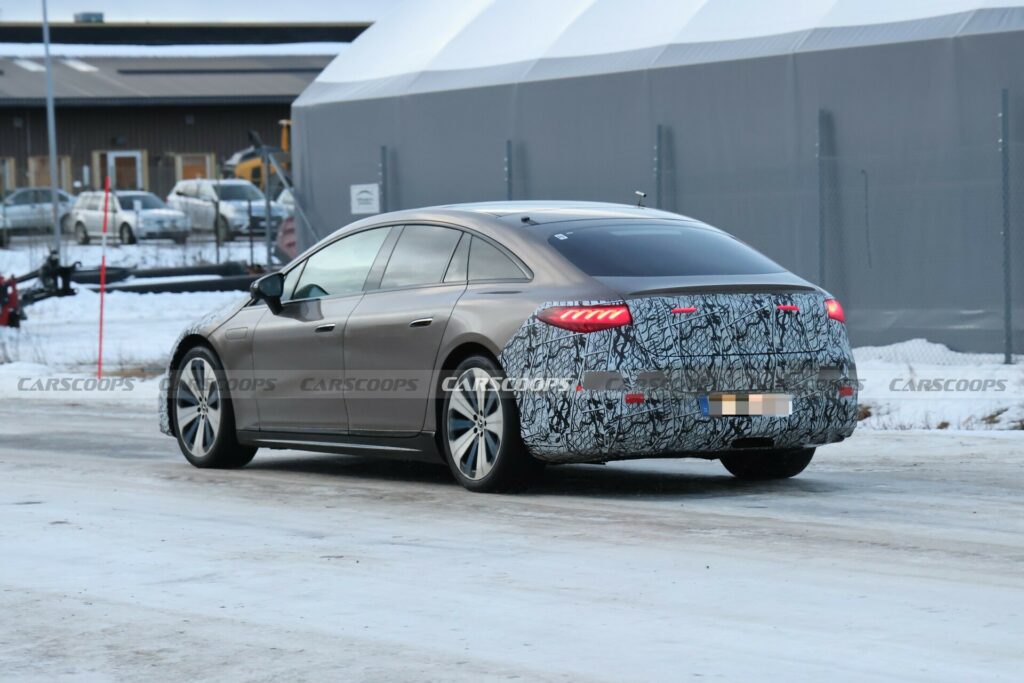
Interestingly, the star graphics are only found up front. However, since most models are slated to get starry taillights, we wouldn’t be surprised to find them on the production EQS.
There doesn’t appear to be any other changes at this point, but it’s hard to be certain with the camouflage. That being said, one of the prototypes apparently suffered an issue as it was seen being towed behind a G-Class. There’s no word on what happened, but the stricken EQS had power as the lights were on.
SHProshots
-
Electric Vehicles - Latest News | Carscoops
- Tesla Outsold Audi Globally Despite Both Brands’ Registrations Dropping In 2024
Tesla Outsold Audi Globally Despite Both Brands’ Registrations Dropping In 2024
- New sales figures reveal Tesla sold more EVs than Audi did all cars during 2024.
- Audi’s sales fell by 12 percent to 1.67 million units last year, having climbed in 2023.
- Tesla registrations dropped 1.1 percent in 2024 but it still shifted 1.79 million cars.
Tesla’s decade of sales growth came to an end in 2024, but the American automaker still managed to claim at least one big scalp. Despite the downturn in its fortunes, Tesla sold more cars than premium rival Audi.
VW’s posh brand registered 1.67 million cars in 2024, that number representing a 12 percent slide compared with the previous year. Tesla’s sales also fell, but only by 1.1 percent to 1.79 million units, putting it ahead of the German automaker, as reported by Bloomberg.
Tesla’s Four Models Beat Audi’s Vast Arsenal
Tesla’s achievement is remarkable for several reasons. One is that it only sells electric vehicles, but managed to move more of them than Audi did electric, hybrid and combustion models combined. Another is that Tesla has only four model lines (five if you include the Cybertruck, but that’s currently available solely in the US and Canada), and none of its global offerings are new, although the Model 3 did at least get a facelift in time to impact the 2024 sales numbers. Audi, in contrast, has dozens of different combinations of model lines and body styles.
Related: 2025 Tesla Model Y Debuts With Cybercab Looks And Turn Signal Stalks
Audi bosses will be particularly disappointed at the news given the success it enjoyed a year prior. In 2023 Audi sold 1.9 vehicles, its best result since 2017, and one that helped it reverse three consecutive years of falling sales. Tesla, on the other hand, has been steadily growing all the way through the late 2010s and early 2020s, culminating in an incredible 2023 when its Model Y SUV was the best-selling car on the planet.
Audi vs Tesla Sales
| Year | Audi | Tesla |
| 2024 | 1.67 million | 1.79 million |
| 2023 | 1.9 million | 1.81 million |
| 2022 | 1.6 million | 1.31 million |
| 2021 | 1.68 million | 936,000 |
| 2020 | 1.7 million | 500,000 |
| 2019 | 1.85 million | 368,000 |
| 2018 | 1.8 million | 245,000 |
| 2017 | 1.9 million | 103,000 |
Bloomberg notes that Audi’s sales dropped in large markets like Germany, China and North America. In general, German luxury brands have been hit by a double whammy of sharpy declining demand in China due to increasingly strong local competition and the withdrawal of EV subsidies in key European countries. But since Audi’s EV sales only fell 8 percent and its overall registrations dropped by 12 percent, it’s not fair to place all of the blame on its electric lineup.
Will Fresh Cars (And China’s AUDI) Help In 2025?
Perhaps the arrival of some new metal will make 2025 a more successful year. The elderly combustion A4 has now been replaced (by the A5), and an electric counterpart (which gets the A4 name) is on the way. Audi has also launched the A6 e-tron and Q6 e-tron electric sedans, wagons and SUVs.
The introduction of the new AUDI brand in China (all in capitals and without the four-ring logo) is also designed to help it in the world’s largest car market. A joint venture with SAIC, starting in mid-2025 it intends to launch three EVs in the mid- and full-size segments that were previewed by the E concept last November.

-
Electric Vehicles - Latest News | Carscoops
- Porsche Sold Nearly Twice As Many Macan EVs As ICE In Q4 2024, But There’s A Catch
Porsche Sold Nearly Twice As Many Macan EVs As ICE In Q4 2024, But There’s A Catch
- Porsche sold 310,718 vehicles in 2024, including 102,889 units of the Cayenne.
- The Macan EV sold nearly twice as many units as the ICE version in Q4 2024.
- The electric Taycan sales dropped by 49%, while the 718 lineup saw a 15% increase.
Porsche has released its global sales results for 2024, reporting 310,718 vehicle deliveries, a 3% decline compared to 2023. One of the highlights is the Macan EV, which managed to outsell its internal combustion engine (ICE) counterpart in the fourth quarter of the year. On the flip side, the fully electric Taycan struggled to find buyers, with sales nearly halving compared to the previous year.
The Porsche Macan EV made its debut in January 2024, but customers didn’t get their hands on one until the very end of September. Of the 27,795 units sold in Q4, nearly 66% (18,278) were electric, while the remaining 9,517 were gas-powered models.
Why the Macan EV’s Win Needs an Asterisk
Before anyone pops champagne over the Macan EV outpacing its aging ICE counterpart, it’s important to note that the gas-powered version was discontinued in Europe, one of Porsche’s key markets, as of spring 2024, due to tougher cybersecurity regulations. Buyers in the EU essentially had no choice but to go electric if they wanted a Macan. Meanwhile, in the U.S. and other regions, Porsche still offers both versions side by side.
More: Would You Pick The Porsche Macan EV Turbo Or The ICE Macan GTS To Drive Until It Breaks?
Overall, Porsche sold 82,795 examples of the Macan in 2024 (ICE and EV), a 5% dip compared to 2023’s purely ICE lineup. According to the company, this decline can be attributed to the discontinuation of the ICE model from Europe, and the “staggered introduction” of the Macan EV worldwide.
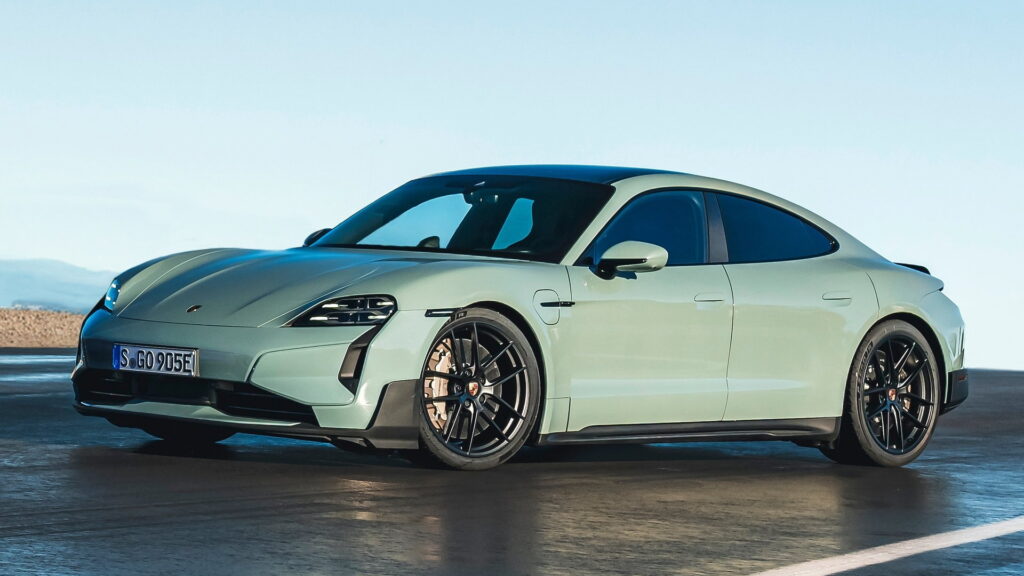
Taycan Takes a Tumble, Panamera Hits a Snag in China
The Taycan suffered the worst sales decline in the Porsche lineup with 20,836 units representing a 49% drop compared to 2023. Porsche suggests that the significant drop is due to the introduction of the facelifted model, acknowledging that the “the ramp-up of electric mobility is generally proceeding more slowly than planned”.
The Taycan was Porsche’s weakest link in 2024, with sales crashing by 49% to just 20,836 units. Porsche blamed the sharp decline on the transition to the updated facelifted model but also admitted that the shift to electric mobility is “generally proceeding more slowly than planned”.
The Porsche Panamera also entered a new generation last year bringing several upgrades compared to its predecessor. However, sales dropped by 13% to 29,587 units, a dip largely attributed to waning demand in the critical Chinese market.
Growth For The Cayenne, 911, and 718
Luckily for the Zuffenhausen brand, the Cayenne has evolved into a buyer’s favorite, accounting for nearly a third of Porsche sales. The SUV sold 102,889 units in 2024, marking a 18% increase over the previous year, while retaining its position as the best-selling member of the Porsche lineup.
More: Porsche Buyers Snap Up Gas-Powered 718s Like It’s 1999 As Taycan Sales Tank
The 911 also held its ground as Porsche’s flagship sports car, delivering 50,941 units and securing third place behind the Cayenne and Macan. The 718 Boxster and Cayman, Porsche’s entry-level sports cars, enjoyed a 15% boost with a combined 23,670 units sold worldwide. Despite this growth, the future of the 718 lineup remains uncertain as Porsche has reportedly pushed back the launch of their fully electric successors.

China Sales Collapse
Regionally, Porsche saw mixed results. Sales grew in Europe (+9%) and North America (+1%), but China, the automaker’s largest single market in recent years, tanked by 28%, with the automaker citing a “continuing challenging economic situation”. While the company remains optimistic about personalization trends, with more buyers adding profitable optional features, it doesn’t change the reality that Porsche is losing significant ground in one of its most crucial markets.
Looking ahead, Detlev von Platen, Porsche’s Executive Board Member for Sales and Marketing, struck a measured tone:
“With the youngest product range in the company’s history, our offering is highly attractive to our customers. At the same time, of course, we do expect that the economic and geopolitical conditions will challenge us more than ever in 2025. Nevertheless, our goal is to further strengthen our brand globally and to exploit market potential. We will do this in line with demand in the individual regions in order to remain true to our principle of value-based sales in the future.”
Below are the detailed sales figures for each model and the regional sales breakdown for Porsche in 2024.
2024 Porsche Global Sales Breakdown
| Model | 2024 | 2023 | Change |
| Cayenne | 102,889 | 87,553 | +18% |
| Macan | 82,795 (EV+ICE) | 87,355 (ICE) | -5% |
| 911 | 50,941 | 50,146 | +2% |
| Taycan | 20,836 | 40,629 | -49% |
| Panamera | 29,587 | 34,020 | -13% |
| 718 | 23,670 | 20,518 | +15% |
| Total | 310,718 | 320,221 | -3% |
2024 Porsche Sales In Different Regions
| 2023 | 2024 | Difference | |
| Worldwide | 320,221 | 310,718 | -3% |
| Germany | 32,430 | 35,858 | +11% |
| North America | 86,059 | 86,541 | +1% |
| China | 79,283 | 56,887 | -28% |
| Europe (excluding Germany) | 70,229 | 75,899 | +8% |
| Overseas and Emerging markets | 52,220 | 55,533 | +6% |
-
Electric Vehicles - Latest News | Carscoops
- Bill Ford Hopeful Trump Will Help US Car Industry, Not Worried About Musk
Bill Ford Hopeful Trump Will Help US Car Industry, Not Worried About Musk
- According to the chair of Ford, Donald Trump “cares very much about the people in the [car] plants.”
- Bill Ford added that he is aligned with Elon Musk on many issues.
- Trump is widely expected to scrap the $7,500 federal EV tax credit shortly after taking office.
The chair of Ford appears confident that incoming president Donald Trump will help the US automotive industry. He has also shrugged off concerns about Trump’s cozy relationship with Tesla boss Elon Musk, echoing recent statements from the new chief executive of Hyundai Motor Co, Jose Munoz.
Bill Ford says Trump called him during the first week of January and told the media they spoke for a “long, long time.” During the first Trump presidency, Ford was repeatedly attacked for its Mexican production plans and drew Trump’s ire after it agreed with Californian regulators to voluntarily meet the state’s fuel economy and tailpipe emissions standards.
Read: Hyundai’s New CEO Says Musk-Trump Friendship Is A “Positive” For All Carmakers
Ford said: “This time he [Trump] understands the importance of our industry,” noting that it took some “education” for him to fully grasp it during his firm term in the Oval Office. Bill Ford added that Trump is eager to connect with auto workers and wants to see the US industry flourish.
Trump wants to “help the American auto industry, and not just the industry itself, but actually help the workers in the industry,” Bill Ford added. “He cares very much about the people in the plants.”
Donald Trump is expected to scrap the $7,500 federal EV tax credit when he takes office. Ford said he spoke about the credits with Trump, and said he feels “very confident going forward that Ford will have a voice and a seat at the table.”

On the issue of Elon Musk seemingly becoming Donald Trump’s right-hand man, Ford told Bloomberg that he and Musk “are aligned on a lot of issues.” This statement comes shortly after Hyundai boss Jose Munoz suggested that having someone like Elon Musk, “who is close to the US industry and to the EV world,” should be a “positive for the industry.”
Chinese profits
While speaking at the Detroit Auto Show last week, Ford chief executive Jim Farley revealed the company earned approximately $600 million in China last year, CNBC reports. This comes despite the fact many Western car manufacturers have begun to struggle in China as consumers begin to favor vehicles built by local brands.
“I’m happy to say that Ford makes money in China, and I’m very proud of that, because not many [automakers] can say that,” Farley said.
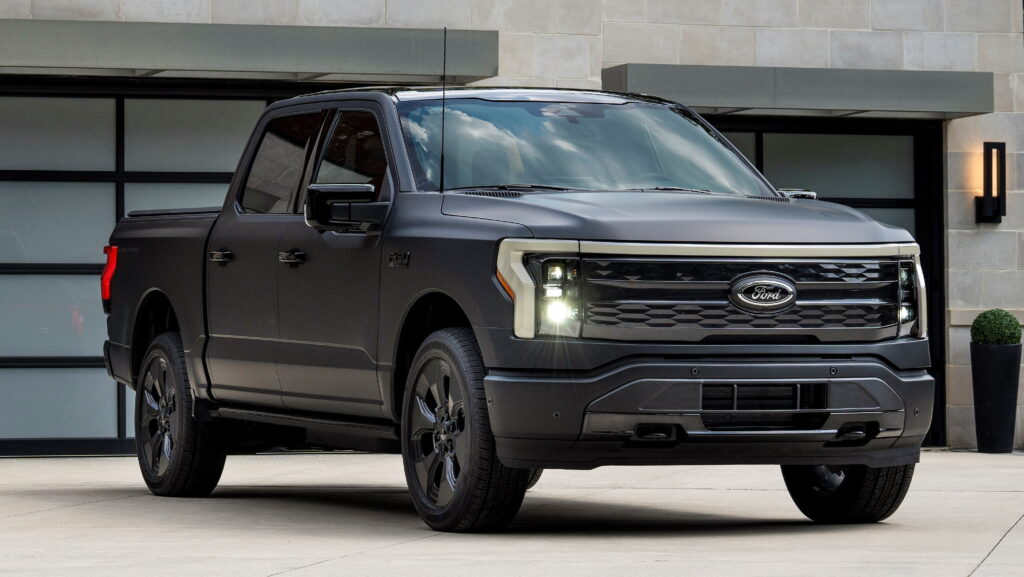
-
Electric Vehicles - Latest News | Carscoops
- Tesla Starts 2025 With Recall For 240,000 EVs, Some May Need New Computers
Tesla Starts 2025 With Recall For 240,000 EVs, Some May Need New Computers
- Over 230,000 Tesla vehicles are recalled for rear-view camera failures linked to firmware.
- The recall includes Tesla Model 3, Model Y, Model S, and Model X electric vehicles.
- Most vehicles can be fixed with OTA updates, but some need new computers installed.
Tesla recalled more vehicles than any other automaker in 2024 and has just issued its first recall for the 2025 calendar year, related to a fault with the rear-view camera. While the issue affects a significant number of vehicles, most can be repaired via a simple over-the-air (OTA) software update—a method that Tesla has leaned on heavily to resolve recall issues without requiring time-consuming dealership visits. That said, some vehicles will need more extensive repairs involving a visit to a Tesla service center.
This recall impacts a total of 239,382 Tesla vehicles, spanning multiple models and production years. Specifically, the impacted vehicles include:
- 2024-2025 Tesla Model 3 units built between January 15, 2024, and December 12, 2024
- 2024-2025 Tesla Model S units manufactured from April 24, 2024, to November 27, 2024
- 2023-2025 Tesla Model X units produced between January 25, 2023, and December 2, 2024
- 2023-2025 Tesla Model Y units assembled from May 23, 2023, to December 16, 2023
According to the carmaker, when an impacted model is powered up, a reverse current could cause a shorting failure on the car computer board. This may cause the rearview camera to stop working, impacting the driver’s visibility and increasing the risk of a crash.
Read: Tesla And Stellantis Overtake Ford As 2024’s Most Recalled Brands
Tesla started to notice an increase in car computer replacements from November 21, 2024, due to shorting failures. It traced the issue back to older computer firmware. Tesla had identified 887 warranty claims and 68 field reports related to the rearview camera failure as of December 30, 2024.
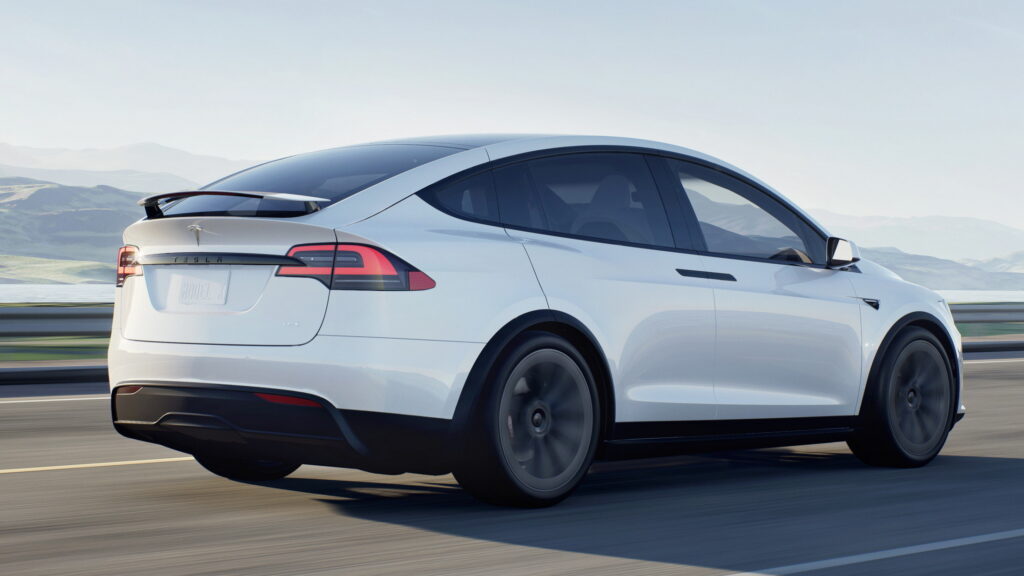
An over-the-air software update started to reach affected vehicles in December and changes the vehicle power-up sequence to prevent the shorting failure condition. However, some vehicles that “experienced the shorting failure condition or stress” may need to have a new computer installed at no cost. Obviously, that will require a visit to a Tesla service center.
Last year, Tesla issued a total of 16 recalls in the US, impacting 5,137,968 vehicles. While it had to recall millions of cars, no less than 5,098,363 were fixed with software updates.
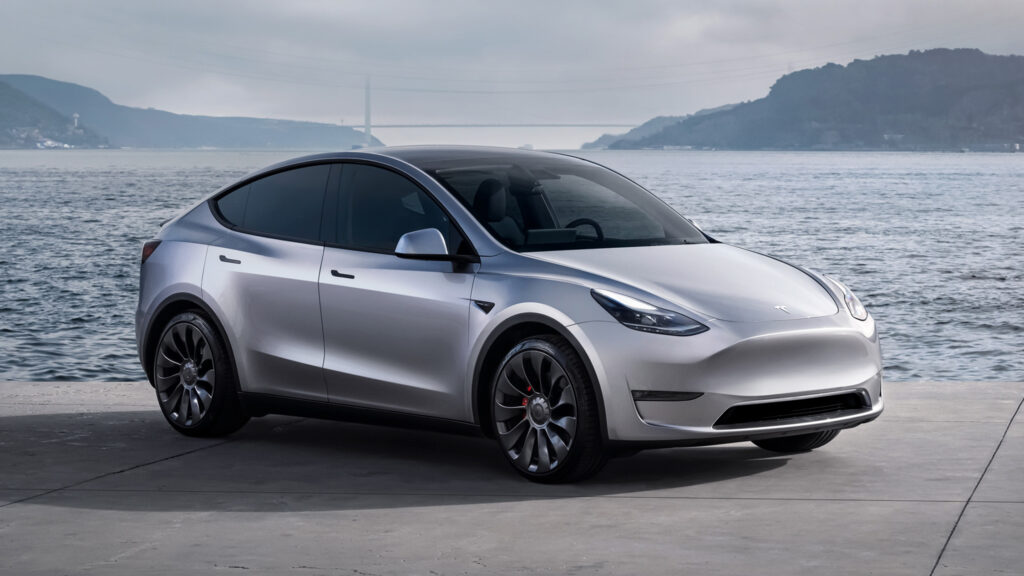
Xpeng’s G7 Is The Latest Flashy Electric SUV From China
- This new model is slightly longer than the big G9 SUV but has a shorter wheelbase.
- At least two versions will be offered, each with battery packs sourced from CALB.
- Local media suggests prices could start at around 200,000 yuan or ~$27,300.
The Xpeng family is receiving a new member known as the G7 and this might just be the firm’s best-looking SUV. Previewed through a series of official photos and images from China’s Ministry of Industry and Information Technology, the G7 slots between the G6 and the G9 in Xpeng’s SUV range, and it’s expected to go on sale during the first half of 2025.
Data reveals the G7 is 4,892 mm (192.5 inches) long, 1,925 mm (75.7 inches) wide, and stands 1,655 mm (65.1 inches) tall with a 2,890 mm (113.7 inches) wheelbase. That means it’s 1 mm longer than the more upright G9, but it does have a 108 mm (4.2-inch) shorter wheelbase and also sits much lower. As with other Xpeng models, the G7 looks quite attractive.
Read: Xpeng’s $280,000 AeroHT Mothership Launches 2-Seater Drone From Its Boot
Found up front are the same slim LED DRLs and light bar found across the brand’s portfolio, including the new P7+. The main headlamps are positioned below these DRLs, and there’s no traditional grille in sight. Instead, most of the front fascia is body-colored, except for the lower portion, which is finished in gloss black and includes air vents that can open and close.
The side profile of the G7 shows it has a low roof and a streamlined design, looking not dissimilar in shape to the Kia EV6 with its mix of sedan and crossover influences. The rear end includes sharp LEDs, a light bar, a spoiler stretching off from the roof, and a black bumper.
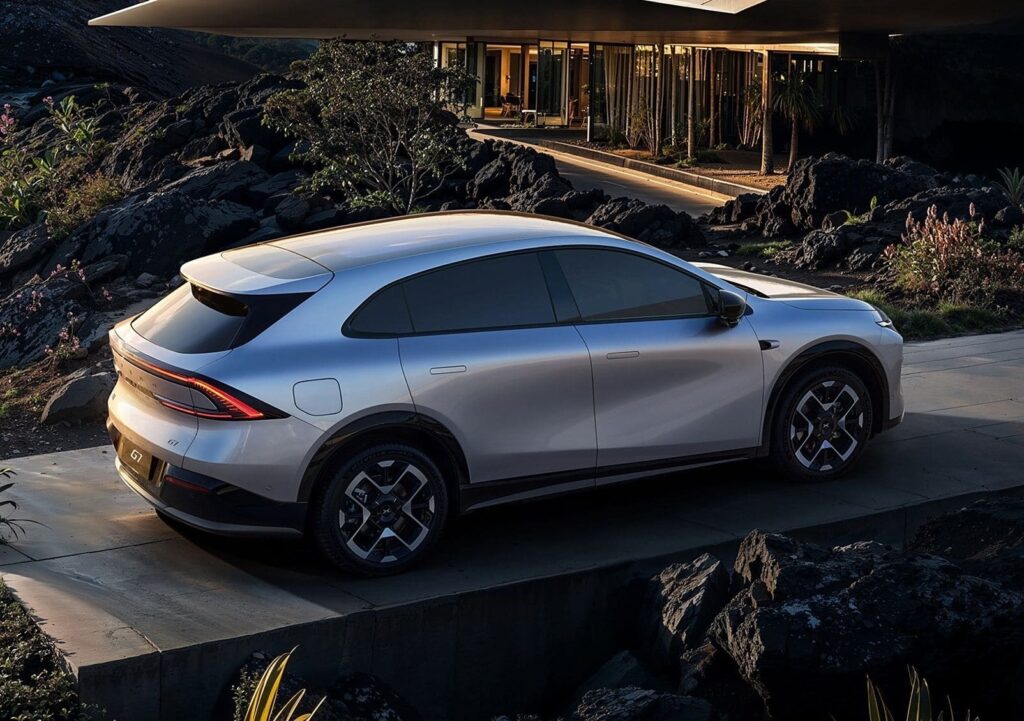
Lower and higher-spec versions of the G7 are tipped to be offered with weights varying between 2,085 kg (4,596 lbs) and 2,160 kg (4,761 lbs). Powertrain details have not been confirmed, but both variants will use CALB lithium iron phosphate batteries.
CarNewsChina suggests that prices for the new Xpeng G7 could start at around 200,000 yuan (~$27,300), making it another compelling, low-priced EV from China.
-
Electric Vehicles - Latest News | Carscoops
- 2026 Genesis GV60 Magma Debuts This Fall With Over 640 HP
2026 Genesis GV60 Magma Debuts This Fall With Over 640 HP
- Genesis’s hot GV60 Magma has been spied testing ahead of a global debut this fall.
- The first car from the Magma series should get the Ioniq 5 N’s 641 hp drivetrain.
- Genesis revealed the updated GV60 last week with a massive 27-inch display.
It’s been a long wait but Genesis’s GV60 line finally gets a dedicated performance model this fall. That’s when Genesis starts building the GV60 Magma, a production version of a hot EV shown in concept form at the 2024 Goodwood Festival of Speed.
Magma is Genesis’s equivalent to BMW’s M and Hyundai’s N brands, and we can expect the badge to find its way to several of the automaker’s models. But the GV60 is first in line and is expected to justify its position at the top of the trim tree by transplanting the 641 hp (650 PS / 478 kW), bi-motor powertrain from the GV’s sister car, the Hyundai Ioniq 5 N.
Related: Genesis Refreshes GV60, Includes New 27-Inch Display
Genesis hasn’t confirmed how much power the Magma will make or whether it’ll also get the 5 N’s simulated manual transmission, a feature that was recently added to the Kia EV6 GT, another electric crossover closely related to the GV60.
Our spy photographers first caught the Magma testing last summer, prior to the Goodwood reveal. But this latest prototype wears far more camouflage because it’s fitted with the finished car’s grille and wheel-arch extensions – parts that weren’t present last time out.

The plastic arch lips don’t have the aggressive-looking slots shown in the concept, but they’re noticeably flared, unlike the stock’s GV’s flush arches. There’s even a hint of Porsche 911 GT3 RS about the lower portion of the front wheel arch just ahead of the door, and it’s not the only similarity.
Instead of the full-length roof rails seen on regular GV60s, the Magma has short versions on the rear half of the roof, a bit like the ones on a 911 GT3. But there’s no sign of the concept’s rear spoiler on this prototype or its gorgeous motorsport-inspired alloy wheels. Hopefully, both will find their way onto later prototypes before the global debut later this year.
We don’t have any interior shots of the Magma, but since Genesis revealed a facelifted GV60 lineup earlier this week, we know that all models will soon feature a huge 27-inch dashboard display combining a digital instrument cluster and touchscreen.
Images: Baldauf
-
Electric Vehicles - Latest News | Carscoops
- Porsche Buyers Snap Up Gas-Powered 718s Like It’s 1999 As Taycan Sales Tank
Porsche Buyers Snap Up Gas-Powered 718s Like It’s 1999 As Taycan Sales Tank
- Porsche sold a record 76,157 vehicles in the US last year, despite the Taycan’s poor performance.
- The 718 and the 911 two-door sports cars increased their sales by 26% and 21% respectively.
- Still, the Macan and Cayenne SUVs remained the two best-selling Porsche models for 2024.
Porsche set a new U.S. sales record in 2024, moving 76,157 units, marking a modest but meaningful 1% increase over 2023. This achievement was largely fueled by strong performances from the Cayenne, 911, and 718 lineups, which more than offset a sharp drop in Taycan sales.
Starting with the Taycan, it sold just 4,747 units in the States throughout the previous year, representing a substantial 37% drop compared to 2023. This performance placed it as the second-lowest seller in Porsche’s lineup, ahead of only the Panamera, which moved 3,982 units.
Sports Cars Step Up: 718 and 911 Shine
The standout success of 2024 was Porsche’s 718 lineup, which saw an impressive 26% surge in sales, totaling 5,698 units. This strong performance meant the Boxster and Cayman twins outsold the Panamera and Taycan sedans in the American market.
The spike likely reflects buyers rushing to secure one of the last combustion-powered models before the lineup transitions to an all-electric future. While Porsche has delayed its EV plans, the looming farewell to gas-powered 718s has undoubtedly fueled demand. That said, with Porsche acknowledging mid-2024 that the shift to an all-electric future will take longer than initially expected, the possibility of ICE-powered versions lingering a bit longer remains open.
More: 2025 Carrera S Returns To Porsche 911 Lineup With 473 HP, But No Manual
The iconic 911 family also proved to be quite popular with US buyers, selling 14,128 units (+21%) last year. According to Porsche, its two-door sports cars, the 911 and 718, together accounted for an impressive 26% of the brand’s total US deliveries last year. Clearly, American enthusiasts aren’t ready to part ways with Porsche’s ICE-powered sports car heritage just yet.

SUVs Reign Supreme, But EV Plans Shift Gears
Unsurprisingly, Porsche’s SUVs remained its bread and butter in the US market. The Macan led the pack with 25,180 units sold, though it saw a 6.6% dip from 2023. Meanwhile, the Cayenne celebrated its best year ever, selling 22,432 units, representing a nearly 10% year-over-year increase.
The Macan’s slight decline comes as Porsche introduced a new all-electric Macan EV. However, flagging Taycan sales and uncertainty surrounding U.S. EV tax credits under the Trump administration appear to have forced Porsche to reevaluate its electrification strategy. In November, the company confirmed that it would continue offering the ICE-powered Macan in North America “for the foreseeable future,” even though the model has already been retired in Europe due to emissions regulations.
Certified Pre-Owned Market Hits New Highs
Porsche’s success wasn’t limited to new cars. The Porsche Approved Certified Pre-Owned program also hit a new record, with 43,249 vehicles sold, a solid 12% increase over 2023. This growth underscores the strong demand for Porsche vehicles, even in the secondhand market.
More: New And Existing Porsches Get YouTube Because Riding Shotgun Is So Boring
Reflecting on the year, Timo Resch, President and CEO of Porsche Cars North America, said:
“The past year has marked a pivotal moment for PCNA. Our brand continued to go from strength to strength, supported by unprecedented new ICE, Hybrid and BEV model introductions, including the new 911, the new Panamera, the new Taycan and the new Macan. As a result we were able to offer our customers the most diverse and complete range of cars in Porsche’s history. I am grateful to every owner, every dealer and every employee for driving this success as our attention focuses on 2025 and the opportunities ahead of us.”
Below you can find the detailed sales numbers for each Porsche model for the US market.
2024 Porsche U.S. Sales Breakdown
| Model | 2024 | 2023 | Change |
| Cayenne | 22,432 | 20,475 | +9.6% |
| Macan | 25,180 | 26,947 | -6.6% |
| 911 | 14,128 | 11,692 | +20.8% |
| Taycan | 4,747 | 7,570 | -37.3 % |
| Panamera | 3,982 | 4,205 | -5.3% |
| 718 | 5,698 | 4,526 | +25.9% |
| Total | 76,167 | 75,415 | +1% |
| 2024 | 2023 | Change | |
| Porsche Approved Certified Pre-Owned sales | 43,249 | 38,788 | +12% |
Hellbender salamanders could be added to endangered species list
A giant salamander called the "hellbender" is on its way to becoming an endangered species. It needs very clean water to survive and that's getting harder to find.
-
NPR Topics: Environment
- Invasive crabs threatened West Coast ecosystems for decades. One solution? Otters
Invasive crabs threatened West Coast ecosystems for decades. One solution? Otters
NPR's Juana Summers speaks to researcher Rikke Jeppesen about her work on how sea otters, which were hunted to almost near extinction, have been able to thrive by eating up to 120,000 crabs a year.
Kindergartner Stuck and Killed by School Bus
A kindergartener from the Hamilton School District in Wisconsin was hit and killed by a school bus on the morning of Jan.2, just two days into the new year.
The Waukesha County Sheriff’s Department released a statement confirming the death of the student amid a fatal bus incident.
According to the statement, the Waukesha County Communications Center was alerted to an incident in which a kindergartener had been struck by a school bus in the Silver Spring Intermediate School parking lot.
The bus was transporting students when the incident occurred. The Kindergartener, whose name was not disclosed at this writing, was at Silver Spring Intermediate School awaiting transfer to a shuttle bus to be taken to Willow Springs Learning Center. That’s when the school bus struck and killed the student.
Authorities say the cause of the incident is still under investigation, and the bus driver is cooperating fully with the investigation. This is a developing story.
Related: New York Student Struck and Killed by School Bus
Related: Wisconsin Child Fatally Struck by Car While Waiting for School Bus
Related: Teen Struck, Killed by Kentucky School Bus
Related: Missouri Student Struck, Killed By School Bus
The post Kindergartner Stuck and Killed by School Bus appeared first on School Transportation News.